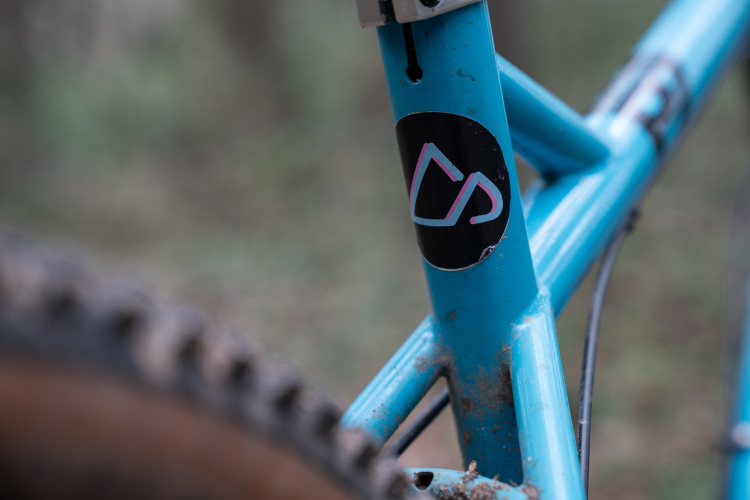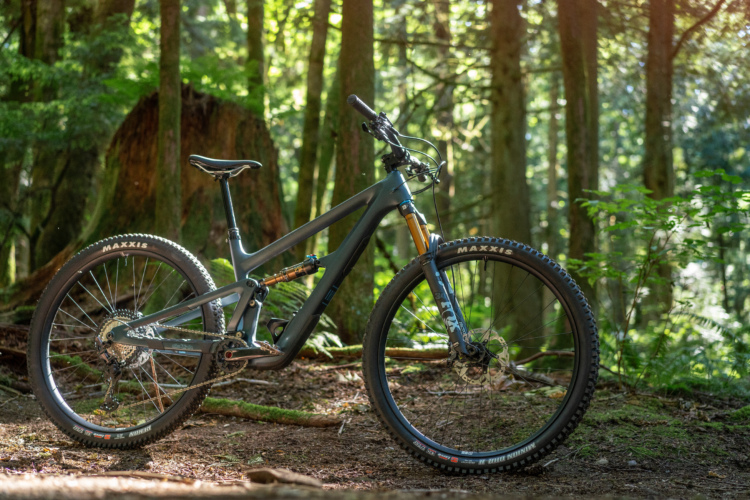
Thule had the Helium Platform 2 tray-style bike rack in development for quite some time. We first saw a peek at the final Interbike in 2018, and the rack was finally unlatched to the public this spring.
The idea follows other tray racks like 1UP and Saris’ new MTR. The Helium fits modern, long mountain bikes with arms that only clamp down on the tires leaving the frame, fork, and wheels untouched.
The Helium frame is made mostly from aluminum, with plastic bits here and there. The construction keeps the weight really low for a full tray bike rack, and altogether it weighs just over 43lbs. The capacity for each tray is 37.5lbs and they are spaced 10 inches apart. The rack fits wheel sizes between 26- and 29-inches, up to three inches wide.
The rack fits in 1.25- and 2-inch receivers, with its own locking hitch pin and mechanism, called the SnugTite Stinger. Thule makes two variations; a single tray rack, the Platform 1, for $450, and the Platform 2, for $700 at Backcountry and other retailers.
Thule Helium – Setup and installation

Totaling the amount of time from when I opened the box, threw cardboard pieces across the garage, bolted the rack together, and had it on the back of my truck, it took less than an hour to mount the rack. Most of the time is spent attaching each tray and arm to the center piece. They are attached with three hex bolts, and the rack feels nice and sturdy after they are installed.
I wasn’t sure what to expect with the SnugTite Stinger, but I’ve come to love it. Sliding the rack into the receiver, the hitch-pin-sorta-thing that looks like a scorpion’s tail snaps into the hole for the hitch to lock it into a place. Turning the dial on the back, a wedge drives and expands in the receiver for a wobble-free fit. After locking the dial, it’s good to go without a typical locking hitch pin. I haven’t touched the dial in months and it’s still tight.

Thule Helium – On the road
The Helium 2 folds up and down like any typical hitch rack. Up, for the stowaway position, level to transport bikes, and down to access the rear of the vehicle. With the Helium’s light weight, most people shouldn’t have a problem lifting it up or down. If my handlebars were a full 800mm wide, I may have had a problem accessing the rear of my vehicle, but I still had enough room between the rear door and my 770mm wide bars to pop it open. There are obviously a few variables at play here, including the type of vehicle and bike in use.

The functionality of the Helium is simple without anything gimmicky. The trays are on the narrower side, which I like because it gives the rack a neater appearance when it’s not in use. Because the trays are more narrow than the Saris MTR which I use as well, I have to open the arms farther on the Helium to fit a bike. Pushing the arms to meet the tires gives a satisfying “click, click, click” from the latching mechanism. Push against the tire again, squeeze the handle, and pull the arm to open to remove the bike.

The Thule Helium isn’t the strongest rack out there. The weight limit is 37.5lbs per tray, which is near enduro and downhill bike territory, and at or under the limit for eMTBs. I did transport an e-bike on this rack, the Turbo Levo SL, which weighed about 40 pounds. I didn’t have any issues with it aside from swaying, though the rack is not intended for a bike that heavy. If transporting heavier bikes is a must, it’s a good idea to put the bike on the inner-most tray.

The arms are locked with a ratcheting mechanism that runs along the side, which is the only thing that reinforces them. While it creates a lock for the bike that is stiff enough, there is still some back and forth swaying of the bike while it’s in the tray. I’ve blasted down BLM roads with two mountain bikes in the rack and done some minor off-roading (also against the rules in the Thule manual) and felt absolutely fine about it, but I would not use it with two e-bikes that exceed the weight. For most people with regular mountain bikes, it shouldn’t be an issue.


The built-in locks on the Thule Helium look about as promising as tying your bike up with a brake hose. They are there to keep honest people honest. I have used them to run into a grocery or convenience store very quickly, but a nice set of garden shears would likely free the bike in a snap. Rather, I would use something like an Abus Brooklyn chain to secure the frame to the arm of the rack. I also found out on my last trip, (the one with the dusty BLM roads) that the locks can get stuck when they get caked with dirt and mud. I usually leave a thick cable with a U-lock, or the above-mentioned Abus chain in my vehicle for such occasions.
Closing thoughts

The Thule Helium Platform 2 isn’t a perfect hitch bike rack. I’m preemptively hearing comments before publishing about how the design follows one that has already been in existence by another brand for some time. It’s not a great rack if you have multiple heavy enduro, downhill, or e-bikes, and sure the plastic on the rack begs the question of durability compared to other racks.
But, I have been using the Thule Helium since the summer, putting it through real-world conditions including adverse weather, rough roads, and with bikes that are on the chunky side, and I have yet to experience any problems with it. The SnugTite hitch lock is still tight as a drum, the Helium is free of any rattles or noises, and none of the features have skipped a beat. So, the Thule Helium Platform 2 might not be perfect, but I would still recommend it.
- Price: $799.95
- Available at REI and other online retailers.











1 Comments
Feb 12, 2022